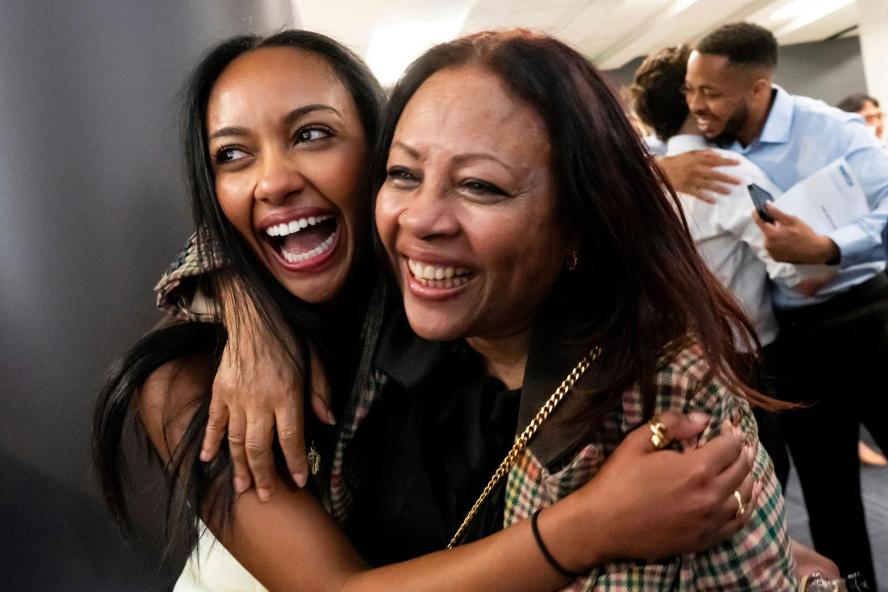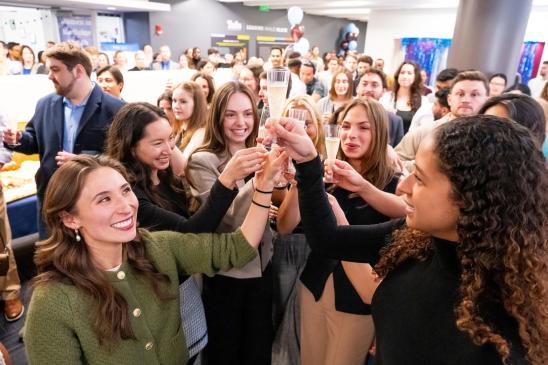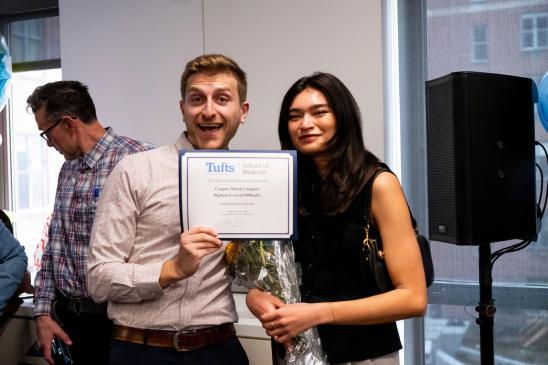-
About
- Departments & Offices
-
Academics
- Physician Assistant
- Special Master’s (MBS)
-
Admissions & Financial Aid
- Tuition & Fees
-
Student Experience
-
- Student Resources by Program
- Academic & Student Support
- Wellness & Wellbeing
- Student Life
- Events & Traditions
-
-
Research
- Research Labs & Centers
- Tufts University-Tufts Medicine Research Enterprise
-
Local & Global Engagement
- Global Health Programs
- Community Engagement
Match Made: Fourth-Year Medical Students Learn Their Next Steps
Celebration at Tufts University School of Medicine on Match Day as future doctors are paired with residency programs around the country.

Every spring, the National Resident Matching Program plugs residency preferences for thousands of graduating medical students — along with hundreds of medical facilities across the U.S. — into a computerized algorithm that will generate their professional matches.
For students, the process can be both stressful and joyful. This year, 17% of fourth-year Tufts University School of Medicine students matched to internal medicine programs, 11% matched for anesthesiology, and 10% for pediatrics.
Here, four graduating medical students speak to Tufts Now about their matches, what medicine means to them, and their hopes for residency.
Michelle Olmos, M25, aspiring neurosurgeon
Michelle Olmos knew from a young age that she wanted to become a doctor. Growing up, she witnessed firsthand the care required to treat an aunt diagnosed with schizophrenia and the positive impacts that doctors could have.
“She'd go to the hospital for treatment and come back home a few days later and be back to who I remembered she was,” says Olmos. “I just thought that was the coolest thing, that somebody could go to the hospital and get treatment and come home and everything would be okay.”
“I got to see what, to a lot of children, would be quite frightening, but it made me ultimately really interested in the brain,” she adds. Olmos is a first-generation college graduate and the first in her family to study medicine.
How the brain functions and the ways that can impact how humans act and interact with others has continued to fascinate Olmos for years. “It hits home a little bit,” she says. She began at Tufts University School of Medicine with plans to study neurosurgery. Her time in medical school solidified that the specialty was a natural fit. Olmos appreciates that neurosurgery will allow her to work with patients in need of critical care, and it means she’ll get to use her hands. Growing up, she assisted her dad — who works in construction — on home projects, and in college, she conducted neurobiology research that involved handling rat cerebellums.
At Tufts, Olmos continued conducting research, publishing more than a dozen papers during her time in medical school. She hopes to keep that work up during her residency and into her career.
She also volunteered with Entre Mujeres, a group that conducts community outreach with Spanish-speaking mothers to answer medical questions and to provide education about health concerns like high blood pressure and diabetes. “I’m Latina, so it was kind of this nice way for me to give back to my community,” says Olmos.
Building relationships with patients, Olmos says, is essential to her future as a doctor. “I think patients do better when physicians spend more time with them,” she says. “I want to be empathetic and not forget that it is a gift to be able to treat patients.”
Her match: Keck Medicine of the University of Southern California. “I’m going home!”
Astia Innis, M25, aspiring orthopedic surgeon
In the summer of 2018, Astia Innis found herself working as a medical receptionist at a pediatric clinic. She had a sense she was interested in medicine, she says, but mostly, “I just needed a summer job.”
Innis was already studying inorganic chemistry at Williams College and was technically on a pre-medicine track. But she wasn’t sure if she would pursue research or another chemistry-adjacent career.
During that summer — in addition to answering phones — she shadowed different roles in the clinic. “That’s where my interest in medicine began,” she says. “I was struck by the trust that the families had in their doctor.” As a physician, “there’s a lot of power, but there’s also a lot of good you could do for people.”
In a gap year between college and medical school, Innis deepened that interest while working in a research lab at Columbia University Irving Medical Center. The experience provided her first real taste of orthopedics. For Innis, who competed as a long jumper and a short sprinter in track and field growing up, there was already a predisposition to the specialty. During her clinical rotations during medical school, the specialty clicked.
“With my background in athletics, and seeing the roles that orthopedic surgeons can play in helping people get back to what they want to do physically, I was enamored by that,” Innis says.
To her, the role that orthopedic surgeons can play in rehabilitating injury was personal. In high school, her younger brother, who was also a competitive track and field athlete, tore his hamstring and his lateral collateral ligament. The injury required significant reconstructive surgery, but it got Innis’s brother back on the track. “Seeing his recovery and the role that an excellent surgeon can play in not just the lives of athletes, but just regular everyday people in staying active and living their lives,” she says, was highly influential in helping determine her specialty.
Her match: UConn Health in orthopedic surgery.
Isabella Stettler, M25, aspiring ophthalmologist
As a college student at the University of California, Los Angeles, Isabella Stettler studied neuroscience and conducted clinical research. She volunteered at a local emergency department, which exposed her to patient interactions and the machinations of the medical field. Combined, she says, the experiences steered her toward a career in medicine.
When matriculating at the School of Medicine, Stettler wasn’t set on a specialty, just the elements of medicine she enjoyed. “I knew that I liked surgery, I knew that I liked procedures, and that I preferred being in the outpatient setting versus in-patient, because you can cultivate patient relationships much more deeply,” she says. Ophthalmology checks all of those boxes.
But it was additional research experience that solidified her choice. Between her third and fourth years of medical school, Stettler took a research year to work at the Harvard Retinal Imaging Lab, a part of Harvard Medical School where research includes identifying biomarkers for disease and incorporating machine learning in ophthalmic imaging. “It’s just so special to be in a specialty where you can have an impact on someone’s sight,” she says.
Stettler has a specific interest in health accessibility and pursued a dual MD/MPH, in part to better understand the politics, corporate interests, and other external factors that influence patient health and how doctors are able to practice. At Tufts, she spent a summer conducting research that involved interviewing incarcerated people about their interest in pre-exposure prophylaxis, a medication used to avoid HIV infection. “That was inspiring for me, in thinking about how to create interventions for people who may not have ideal access to health care,” Stettler says.
In the future, Stettler hopes to combine her interest in research, ophthalmology, and international public health. During her time at Tufts, Stettler did a global rotation in ophthalmology at Korle Bu Hospital in Accra, Ghana, where she had the opportunity to work with local and global ophthalmologists. “Learning from local experts in the field and observing the impact of cataract surgery outreach programs is what really inspires me to pursue a future in global ophthalmology,” Stettler says.
Her match: Tufts Medical Center/New England Eye Center in Boston, Massachusetts. “Tufts is where I fell in love with the specialty to begin with, and I think the faculty and residents were so welcoming,” says Stettler. “I knew it was going to be a place where I could grow into an ophthalmologist and have many opportunities to progress in this field.”
Daniel Kent, M25, aspiring urologist
Daniel Kent has always been a “tinkerer and a fixer.” Growing up, he worked on cars and bicycles, and before medical school, he did a one-year stint as a car mechanic in Florida. While at the School of Medicine, he volunteered at Bikes Not Bombs, a bike shop in Jamaica Plain that donates bicycles to people who would benefit from them.
Medicine, Kent says, combines his long-lived interest in fixing things with a love of science, but with the added bonus of “actually getting to treat people and develop close relationships with people in the community,” he says.
His trajectory has a model: Kent’s father worked as a car mechanic before deciding, in his mid-20s, to go to college and pursue medicine. Today, he’s an anesthesiologist. Kent grew up watching his dad interact with patients in the community and provide emergency medical care when it was needed during family vacations.
As he begins a residency in urology, Kent says he’s eager to build those same types of relationships with longer-term patients. Urology, Kent says, provides that option, while still allowing him to work with his hands performing surgeries.
Kent studied public health as an undergraduate at Northeastern University, and then pursued an MD/MPH at Tufts. The program gave him a broader grasp on the social determinants of health — environmental and community contexts that influence people’s well-being — as well as additional training in research methods in topic areas such as epidemiology. Kent expects this instruction will prove valuable during his residency and beyond.
“I've learned the skills to work with different groups to actually run a public health program and to make a bigger change in my community,” he says.
He recently returned from a one-month exchange trip to Ghana, where he worked alongside local doctors. The experience helped broaden his view; every hospital — and country — approaches medicine somewhat differently, he says. “Even at Tufts, we see a difference in our clinical rotations,” Kent says.
For his residency, Kent will remain in Boston, after undergoing a challenging and untraditional couples match. Urology is one of two specialties that includes an early match. His partner, Isabel Stettler, is pursuing the other: ophthalmology. Rather than linking their applications together, as many couples do, Kent and Stettler had to apply for residency separately and hope for the best.
“We were really happy and grateful for all the help, mentorship, and guidance we received to get us here, but it was definitely, I think, one of the most challenging matches you could do. We're glad it worked,” he says.
Now the couple is working to make matching easier for couples following in their footsteps. They’re submitting letters to the premiere journals of both their specialties to advocate for a process that is more flexible in terms of match timing.
His match: Lahey Hospital and Medical Center Clinic in Burlington, Massachusetts, a part of the Beth Israel Lahey Health System. His match is 20 minutes outside of Boston, where Stettler will also be based. “It worked out — it worked out perfectly,” Kent says.


